ITF-2 (en)
- ITF-2 OVERVIEW
ITF-2 is a Ultra-small artificial satellite developed by Yui Project, Univ. Of Tsukuba
In September 2014, ITF-2 obtained the Launch Opportunity by 'Kibo' Ultra-small Sat. Deployment program.Ever since then, Project members have devoted themselves to its development and missions to be carried out.Click here to know more about the Launch Opportunity and Deployment program.
In 2017 , ITF-2 was successfully deployed from ISS Japanese Experimental Module 'Kibo' .
Inheriting the fundamental design and layouts of its predecessor ITF-1, further enhancement has been made in it's overall credibility and downlink data variations, thus, making it a superior version of ITF-1.

ITF-2 (YUI No.2) FRONT

ITF-2 (YUI No.2) BACK
ITF-2 (YUI No.2) SUMMARY
Name
ITF-2
Nick Name
YUI 2
Size
1U(110.5×108.0×111.5mm)
Mass
1.39 Kg Approx.
Signals Transmitted
From Sat. to Ground
Frequency 430MHz Band
Morse, Audio , AFSK
Signals Transmitted
From Ground to Sat.
Frequency 430MHz Band, 144MHzBand
AFSK
Orbit
Altitude 400㎞
Inclination 51.6 Degrees
Operation Period
3 to 4 months
- ITF-2 Missions
1.Construction of 'YUI' Network
'YUI' Network is a community created by people who share in common the experience of receiving signal data from our satellite. Our aim is to connect people ,who otherwise would not have anything in common, by the common experience of receiving signals from ITF-2.Constructing a network for the growing community would be what we call the YUI NETWORK's mission.
In the ITF-2, the telemetry data is transmitted in FM.By letting people from all over the receive our satellites' signals that change every minute every seconds, we hope to provide a fun and interactive way to bring about the curiosity and interest towards space exploration.We also welcome reception reports in our Web site and plan to develop an environment where people sharing the common experience of receiving our signals, get to know each other.We think this will connect people with common interest around the world.
In addition, we plan to collect messages at public demonstrations and send it to ITF-2 for downlink. These messages will be sent to all receivers around the world.This exchange of messages ,we think , would lead to a new link between people.
2.Demonstration of Ultra-small antenna
The antennae used in devices created with MEMS technology and RFID are being made much shorter than the wavelength. In the near future, Field of Ultra-small Satellites may rely on these technologies for further enhancement and increased credibility of the satellite
As a step towards it , in ITF-1, we incorporated an Ultra-small antenna which we developed for 415MHz Amateur Band and further in ITF-2 , an enhanced version of it has been equipped in the same frequency band.The mission is to test the working of this antenna using AFSK. Confirming it's performance would make the choice of antennae broader in the field of Space exploration and satellites.
3.Demonstration of the New Microcontoller
Up untill now, considering it's high radiation resistivity which is tested in space , microcontrollers such as PIC 16F877 were the preferred choice when it came to the Control System.Our market today has a new type of microcontroller namely FRAM(Ferroelectric RAM) microcontroller which is said to have a high radiation resistivity. We have equipped MSP430FR5739, the new kind of microcontroller into the satellite to test its stability in space.
Devices which are not tested in space before are risky to use it as a main device.Therefore, it will be used such that it would not have impact on any other missions.Evaluation of the device is done by keeping track of single event latchups and upsets.
- Flow of Development
Under construction
- Teams
Development of ITF-2 required 7 developer's team and a mission promotion team. Links to the description of these are found belowの。
Descriptions
- Power Supply System
- Communication System
- Ground Station
- C&Dh系
- Thermal System
- Structure System
- Attitude Control System
Mission promotion
Progress report
- If you want to know our latest progress, please click here.We report not only satellite development, but also application for reporting reception and receiving kit.
How to receive
- If you want to know how to receive signal from ITF-2, please click here.We report how to make handmade antenna and the details of receiving kit.